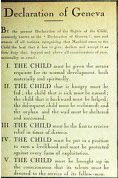Declaration of the Rights of the Child, 1959
About the Declaration
In 1959, the United Nations General Assembly adopted the Declaration of the Rights of the Child. It marked the first major international consensus on the fundamental principles of children’s rights.
Origin of the Declaration of the Rights of the Child
 In 1924, the League of Nations (LON) adopted the Geneva Declaration, a historic document that recognised and affirmed for the first time the existence of rights specific to children and the responsibility of adults towards children.
In 1924, the League of Nations (LON) adopted the Geneva Declaration, a historic document that recognised and affirmed for the first time the existence of rights specific to children and the responsibility of adults towards children.
The United Nations (UN) was founded after World War II. It took over the Geneva Declaration in 1946. However, following the adoption of the Universal Declaration of Human Rights in 1948, the advancement of rights revealed the shortcomings of the Geneva Declaration, which therefore had to be expanded.
“Several [UN] Member States were calling for a convention, that is, an international tool that would legally bind the States that had ratified it, but this proposal was not adopted.” [our translation – to check] (1)
They thus chose to draft a second Declaration of the Rights of the Child, which again addressed the notion that “mankind owes to the Child the best that it has to give.”
On 20 November 1959, the Declaration of the Rights of the Child was adopted unanimously by all 78 Member States of the United Nations General Assembly in Resolution 1386 (XIV).
Content of the Declaration of the Rights of the Child
“The child is recognized, universally, as a human being who must be able to develop physically, mentally, socially, morally, and spiritually, with freedom and dignity.” [our translation] (1)
However, neither the 1924 Geneva Declaration nor the 1959 Declaration of the Rights of the Child define when childhood starts and ends, mainly to avoid taking a stand on abortion.
Nonetheless, the Preamble to the Declaration of the Rights of the Child highlights children’s need for special care and protection, “including appropriate legal protection, before as well as after birth.”
The Declaration of the Rights of the Childlays down ten principles (2):
- 1. The right to equality, without distinction on account of race, religion or national origin.
- 2. The right to special protection for the child’s physical, mental and social development.
- 3. The right to a name and a nationality.
- 4. The right to adequate nutrition, housing and medical services.
- 5. The right to special education and treatment when a child is physically or mentally handicapped.
- 6. The right to understanding and love by parents and society.
- 7. The right to recreational activities and free education.
- 8. The right to be among the first to receive relief in all circumstances.
- 9. The right to protection against all forms of neglect, cruelty and exploitation.
- 10. The right to be brought up in a spirit of understanding, tolerance, friendship among peoples, and universal brotherhood.

